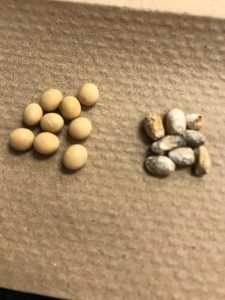Seed Quality Issues a Concern in 2019 Soybeans
The following is posted on behalf of Dr. Nathan Kleczewski, Field Crops Pathologist for Growmark. This content is from the Field Crop Disease Hub webpage Dr. Kleczewski curated.
This year many in the Illinois agricultural community have had questions and concerns regarding soybean seed quality. If you recall, many areas in Illinois suffered from persistent late-season rains which delayed harvest by several weeks. Unfortunately, these wet conditions also favored infection of soybean seed by fungal diseases. In Illinois, the most commonly observed organism associated with seed issues was Phomopsis seed decay (PSD), a common, residue-borne fungal pathogen. Signs of PSD include shriveled, white seed (Figure 1). These seeds are often light and have a dry, chalky appearance. Infection of seed by PSD can result in reduced germination and thus, can be a particular concern in seed production fields. Only rarely is yield impacted by PSD.

What can seed producers do to minimize the impact of poor quality, PSD infected seed? First, ensure lots with significant amounts of damaged seed (>15-20%) are cleaned if possible. Lower amounts of damaged seed = fewer quality/germination issues. Second, PSD development is halted when seed is stored under dry conditions. PSD growth halts when seed moisture is below 19%, and the fungus can die if conditions are sufficiently dry for a long enough period of time. Third, germination tests are essential and should be conducted early in the year. Lastly, if PSD and seed treatment levels are below 80%, consider a fungicide seed treatment. Realize that other factors can cause germination issues as well, and seed treatments will not revive dead and damaged seeds. In addition, the efficacy of seed treatments varies with active ingredients and rate.
In seed production fields, seed quality can be improved with foliar fungicide applications made between the R3-R5 growth stages. However, research indicates that products can differ substantially in their efficacy on PSD. Remember that even if a fungicide is applied, it does not guarantee that quality issues will not be encountered, particularly in conditions similar to what was experienced in 2018. As mentioned previously, yield typically is not increased when PSD is the prevalent disease.
Producers should ensure that they purchase high-quality seed and avoid planting into cool wet soils if possible to minimize additional germination issues.
For more information on Seed treatments and foliar fungicides for PSD management, visit the Crop Protection Network by clicking here.





